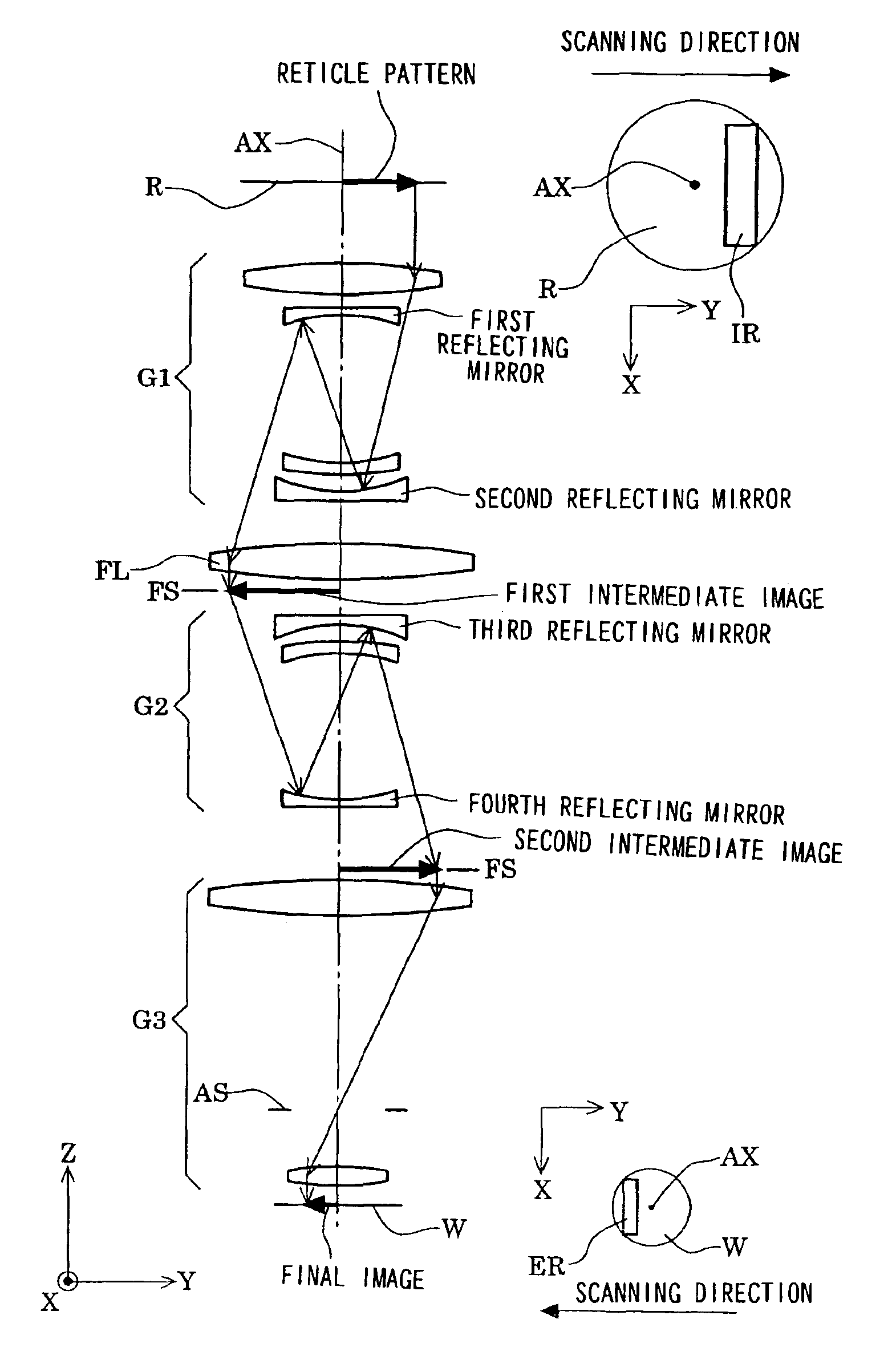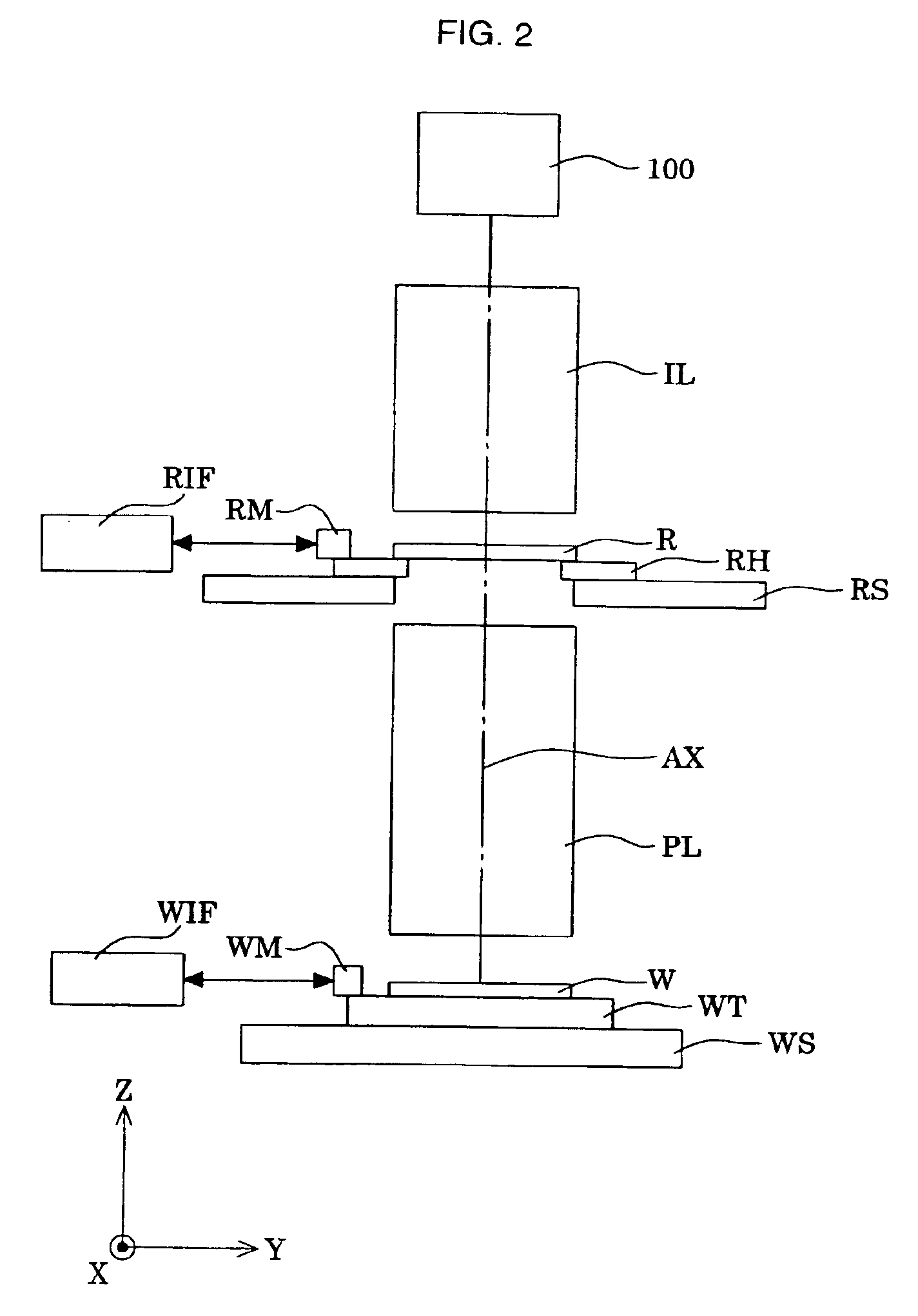Catadioptric system and exposure device having this system
- Summary
- Abstract
- Description
- Claims
- Application Information
AI Technical Summary
Benefits of technology
Problems solved by technology
Method used
Image
Examples
embodiments
[0076](Embodiments)
[0077]The following is an explanation of embodiments of the present invention, given in reference to the attached drawings.
[0078]FIG. 2 schematically illustrates the overall structure of an exposure apparatus having the catadioptric system achieved in any of the embodiments of the present invention as its projection optical system. It is to be noted that in FIG. 2, the Z axis is set parallel to a reference optical axis AX of the catadioptric system constituting a projection optical system PL, the Y axis is set parallel to the drawing sheet of FIG. 2 and the X axis is set perpendicular to the drawing sheet within a plane perpendicular to the optical axis AX.
[0079]The exposure apparatus in the figure includes a light source 100 constituted of an F2 laser light source (with an oscillation central wavelength of 157.6 nm) to supply illuminating light in the ultraviolet range. Light emitted from the light source 100 uniformly illuminates the reticle (mask) R having a sp...
sixth embodiment
[0082]FIG. 3 shows the positional relationships between the rectangular exposure area (i.e., the effective exposure area) formed on the wafer and the reference optical axis. As shown in FIG. 3, a rectangular effective exposure area ER in a desired size is set at a position off the reference optical axis AX along the −Y direction within a circular area (image circle) IF with a radius A (which corresponds to the maximum image height) centered around the reference optical axis AX in all the embodiments except for the The effective exposure area ER measures LX along the X direction and measures LY along the Y direction.
[0083]Thus, the rectangular illumination area IR with a size and shape corresponding to those of the effective exposure area ER is formed on the reticle R at a position off the reference optical axis AX along the +Y direction as shown in FIG. 1. Namely, the rectangular illumination area IR with a desired size is set at a position off the reference optical axis AX along t...
first embodiment
[0094](First Embodiment)
[0095]FIG. 4 shows the lens configuration adopted in the catadioptric system (projection optical system PL) in the first embodiment. In the catadioptric system in FIG. 4, the first image forming optical system G1 is constituted with, starting on the reticle side, a positive meniscus lens L11 having an aspherical convex surface set facing toward the wafer, a positive meniscus lens L12 having an aspherical convex surface set facing toward the wafer, a concave reflecting mirror M11 having an almost flat concave surface set facing toward the wafer, a negative meniscus lens L13 having a concave surface set facing toward the reticle and a concave reflecting mirror M12 having a concave surface set facing toward the reticle.
[0096]In addition, the second image forming optical system G2 is constituted with, starting on the reticle side, a concave reflecting mirror M21 having a concave surface set facing toward the wafer, a negative meniscus lens L21 having a convex sur...
PUM
 Login to View More
Login to View More Abstract
Description
Claims
Application Information
 Login to View More
Login to View More - R&D
- Intellectual Property
- Life Sciences
- Materials
- Tech Scout
- Unparalleled Data Quality
- Higher Quality Content
- 60% Fewer Hallucinations
Browse by: Latest US Patents, China's latest patents, Technical Efficacy Thesaurus, Application Domain, Technology Topic, Popular Technical Reports.
© 2025 PatSnap. All rights reserved.Legal|Privacy policy|Modern Slavery Act Transparency Statement|Sitemap|About US| Contact US: help@patsnap.com



